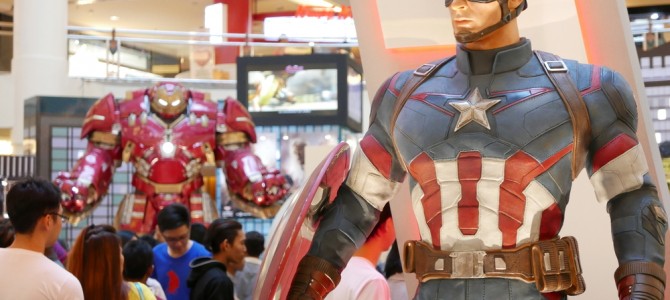
Put away the dark dystopia of modern malaise, mix in some distinct characters and big explosions. Add a fun, self-deprecating script and a soft heart that actually gives people hope instead of sending them to the doctor to up their Prozac prescription, and you’ve got “The Avengers: Age of Ultron.”
From the first moments of the first action-packed scene, the Avengers assemble: Iron Man (Robert Downey Jr.) with Captain America (Chris Evans), the Hulk (Mark Ruffalo) with Black Widow (Scarlett Johansson), and Hawkeye (Jeremy Renner) with Thor (Chris Helmsworth).
But there’s more. A new pair of talented twins surface with a real grudge against Tony Stark in particular and the Avengers in general. The Scarlet Witch (Elizabeth Olsen) controls minds and manipulates the world with her mind. Her brother Quicksilver (“Kick-Ass’s” Aaron Taylor-Johnson) is fast, like supersonic fast.
The Hydra threat fades when a new villain arises after Stark mucks about with artificial intelligence. Apparently Stark’s been too busy with business, Pepper Pots, and suit soaring to watch movies. Anyone who’s set foot inside a theater since the ’70s could have told him that sentient computer programs never end well.
Let’s Create a Reason for This Movie
The film suffers from a common comic-book problem. Once you’ve saved the world, what is left for the sequel? It takes a powerful villain to make the audience care about the world being destroyed. Like previous Marvel villains, this one serves his purpose, but not much else. He’s no Joker.
Likewise, the need to create reasons to film fight scenes takes the plot in some odd directions. But no one really cares, because we’re not here for intricate plot. We are here for battles, and they are good. The opening sequence gets right to the point, with the team pirouetting through a frenetic battleground amid lots of slo-mo and whizzing, blasting fun.
The other common superhero problem is the perennial existential question: If two invincible super-beings meet in combat, and neither of them can be damaged or killed no matter how many skyscrapers they burst through, does their fall make a sound? In one scene, Iron Man, for the most honorable of reasons, beats the living daylight out of his buddy Hulk. Many structures are destroyed in entertaining ways but nothing really happens, if you get my drift.
Don’t Threaten Me with a Good Time
Director Joss Whedon solves this problem with a hearty serving of humor. You can’t escape the feeling that Whedon and the gang are having a good time making the film, and want to share that glee with the audience. It’s a franchise that has hit its rhythm. One fun scene shows Stark and Thor facing off in a bragging contest about their ladyloves’ important jobs. We all know Gwyneth Paltrow and Natalie Portman aren’t in the movie for contract reasons. But the scene has fun with it.
The movie also toys with its PG-13 rating by using Captain America’s old-fashioned aversion to strong language as a running gag. There are a few minor expletives in the film, a couple lines of innuendo that will go right over kids’ heads, and no sexual content beyond a few married kisses. The battles are intense but not gory. Many directors chafe at this restriction. Whedon turns it into an inside joke. It works, delivering a film both funny and fun.
The sweet core of the franchise makes a frankly odd story of very different superheroes a huge reliable hit. It’s not too much to say that the Avengers each represent a stream of current American thought: Captain, the traditional man longing for the moral clarity of the past; Stark, the innovator who believes technology will save the world; Hulk, the lefty pacifist in conflict with his own nature; Thor, the awkward but powerful immigrant; Hawkeye, the Millennial just trying to make his way in life; and Black Widow, the damaged cynic. They have very different values and priorities that often lead to serious conflict.
But when push comes to shove, the Avengers assemble. The values that bind them vastly outweigh the ideas that separate them. It’s a message of hope and reassurance that America and the Western world need, one that audiences desperately want to see in real life as well as in movies. If they can laugh along the way, they’ll line up in droves.









